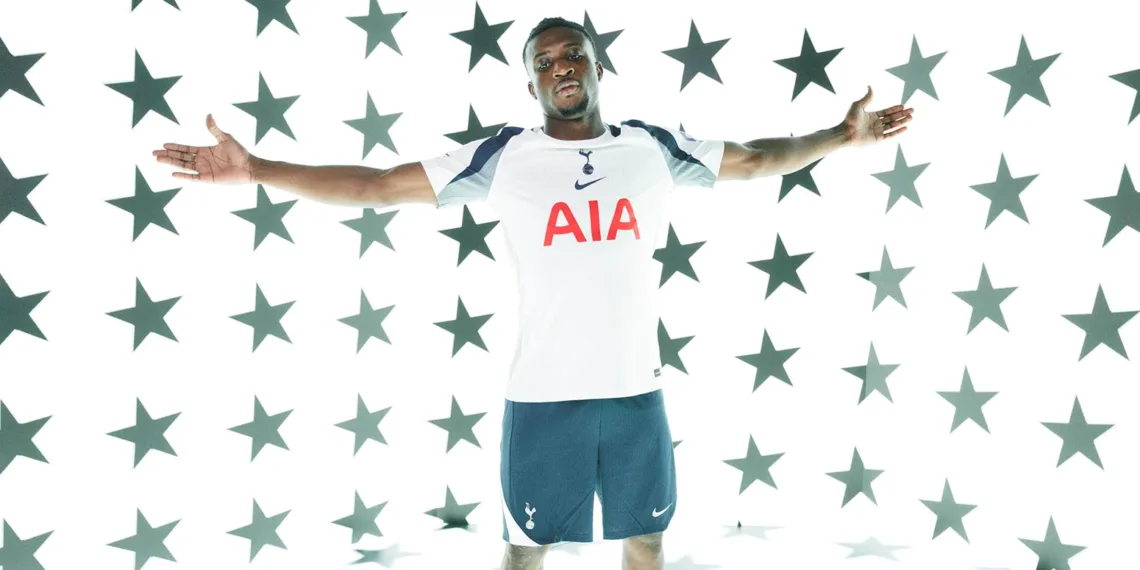Tottenham Hotspur had been missing a top-tier dribbler until they finalized the signing of Mohammed Kudus from West Ham this week. Here’s a look at what he might add to the North London squad.

Table of Contents
Why Tottenham Hotspur Bet on Mohammed Kudus’ Dribbling Prowess
So, why did Spurs decide to sign Mohammed Kudus? The answer is straightforward — the team lacked a truly exceptional dribbler, and new manager Thomas Frank clearly wants to strengthen their attack with one.
Kudus is an elite dribbler. Last Premier League season, only Manchester City’s Jérémy Doku completed more dribbles (107) than Kudus (92). Even on a per-90 minutes basis, Kudus (3.2) was second only to Doku (6.4) among players with over 1,000 minutes played.
It’s important to note that Doku played for a team that dominated possession and attacking play far more than Kudus’ West Ham. Doku averaged 71.9 touches per 90 minutes, while Kudus had only 52.2.
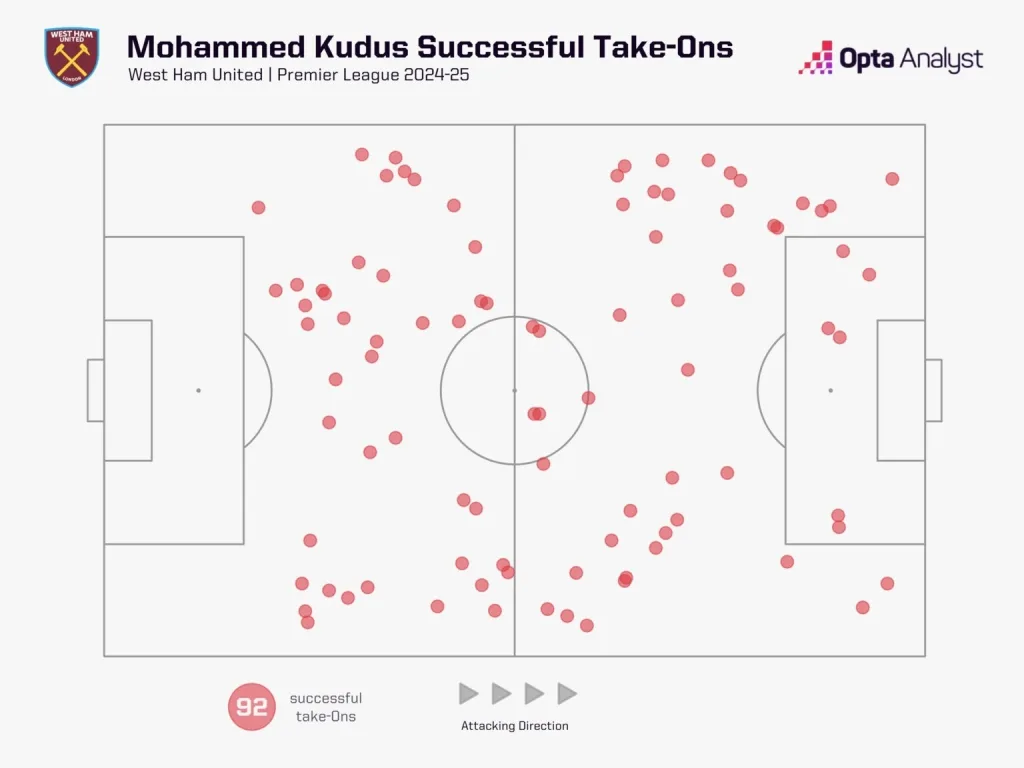
Kudus frequently looks to take on defenders. He told The Athletic last year, “When I see space with the ball at my feet, I don’t care what’s in front of me. I have to go for it.”
Last season, he attempted more dribbles (195) than anyone else in the Premier League. Dribble attempts made up 12.9% of his on-ball actions, and his success rate of 47.2% was relatively high among the league’s most active dribblers. (For comparison, Dejan Kulusevski was the only Spurs player among those who attempted 100+ dribbles, and he had the league’s lowest success rate at just 31.9%.)
In Kudus, Tottenham are acquiring a high-volume, productive dribbler who already knows the Premier League, having spent two seasons at West Ham. His time there was mostly successful — which explains Spurs’ willingness to invest heavily — although his recent season, with five goals and three assists, was less impressive than his debut campaign, where he scored eight goals and provided six assists as West Ham finished ninth.
Mohammed Kudus Can Transform Spurs’ Possession Play and Defensive Balance
By the end of the 2024-25 season, West Ham had become a tough environment, and reports indicate that selling players like Kudus was necessary to finance the rebuild that Graham Potter envisions. Ultimately, Kudus accepted being part of that sacrifice.
The chance to return to UEFA Champions League football was undeniably appealing, as was the prospect of joining a team that dominates possession. A team that could get the ball to him more frequently. Since his impressive 2022-23 season at Ajax—which convinced West Ham to invest nearly £40 million—Kudus hadn’t played in a side focused on controlling the ball.
Although Kudus excelled as a threat on the counterattack during his two years at West Ham, a possession-heavy team should suit him even better. His outstanding dribbling and knack for escaping tight situations could help Tottenham break down stubborn defensive blocks far more effectively than they managed under Ange Postecoglou.
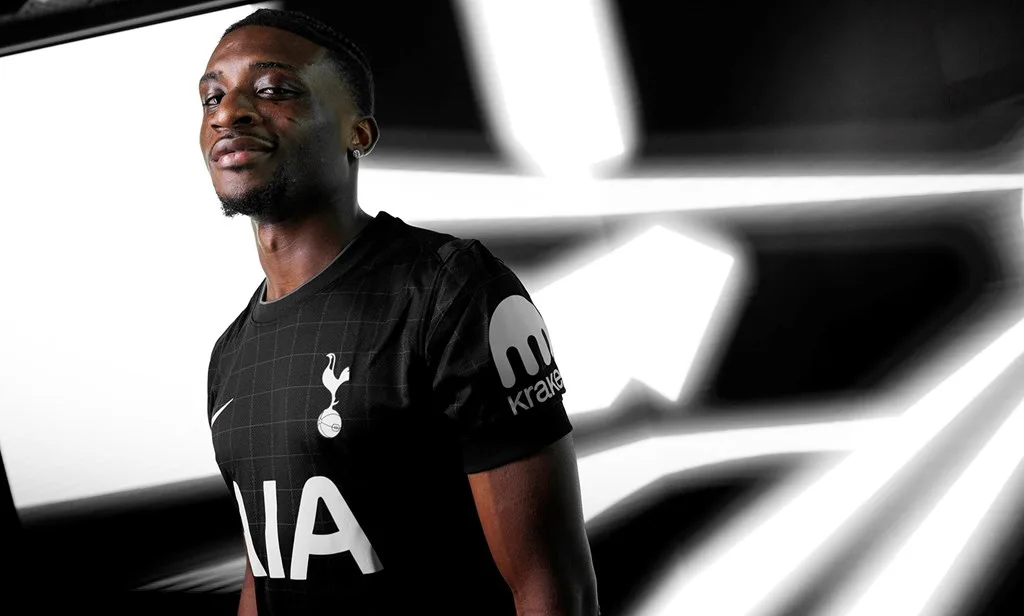
Kudus brings a unique attacking profile to Spurs. While Tottenham players attempted more dribbles than any other Premier League team last season (790), they only ranked ninth in successful dribbles (308) and had the league’s lowest dribble success rate at 39.0%. They lack a truly standout dribbler and instead rely on several players who try dribbles regularly but with limited success.
None of the Premier League’s top 20 players for successful dribbles per 90 minutes last season (minimum 500 minutes played) were Spurs players. Their best dribblers were full-back Djed Spence (1.9 successful dribbles per 90) and the now-departed Timo Werner (1.8). Among current wingers, Mathys Tel led with 1.5 per 90.
Tel and Wilson Odobert are tricky and capable of beating defenders, but Postecoglou preferred wingers who relied on pace and power. Spurs had five players in the Premier League’s top 40 for top speed last season—more than any other club—and four of those were wingers.
Under Postecoglou, Spurs played with quick wingers pushing down the flanks, delivering low crosses into the box. While this style produced many goals, it also saw the team commit too many players forward, leaving their defense exposed. Spurs conceded 65 goals in 38 league games and finished 17th in the table.
A player like Kudus, who can consistently beat his marker better than any current Spurs attacker, could reduce the need to overload attacks with numbers. This might not only improve attacking efficiency but also help strengthen Spurs’ fragile defensive record.
Kudus’ Challenge: Turning Dribbles into Goals for Spurs
The reality is that Kudus had a disappointing 2024-25 season, and while his dribbling skills are impressive, Spurs will expect more end product from their new £55 million signing. In Premier League matches last season, the Ghanaian made 40 carries—moving at least five meters with the ball—that led to a shot or a chance created, yet none resulted in a goal or assist.
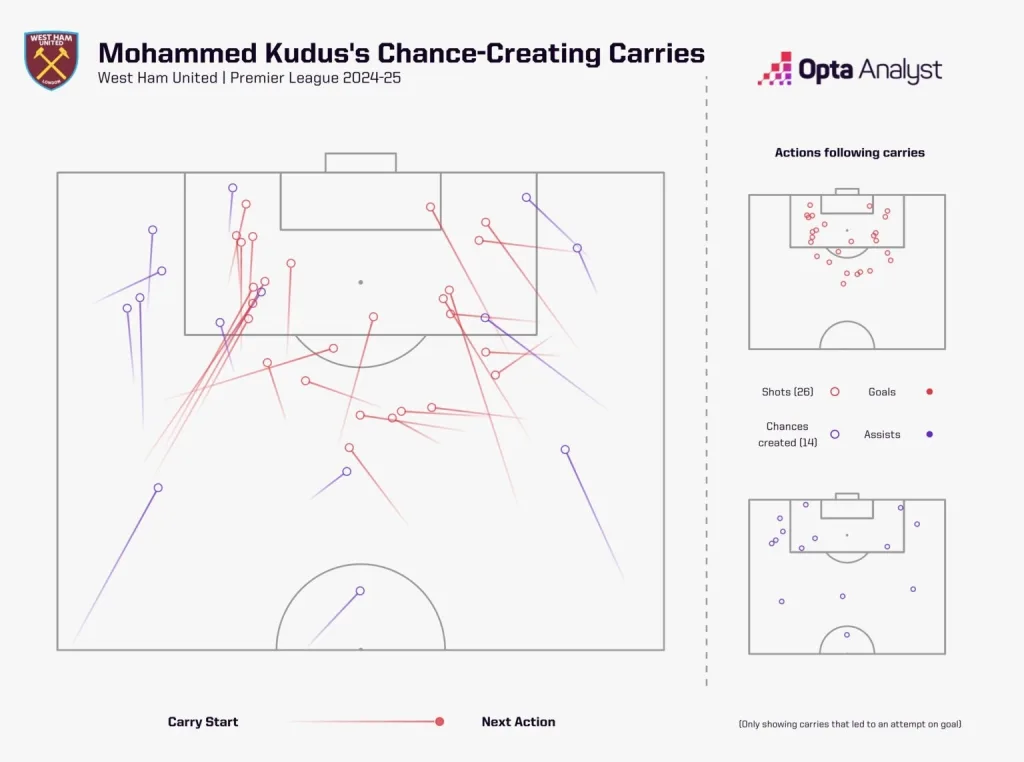
Among 47 players who registered 25 or more carries followed by a shot or chance created, Kudus was the only one not to record a single goal involvement from those actions. Some of this may be attributed to his teammates, but it remains a notable shortcoming that he must address.
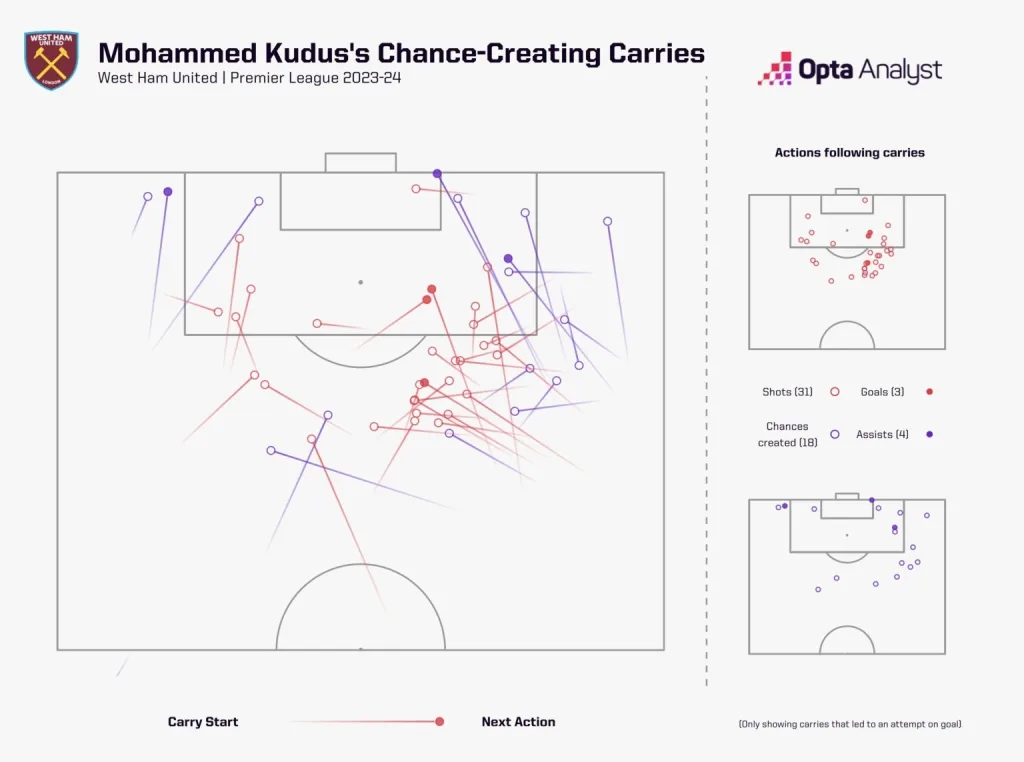
It’s really the previous season that caught Spurs’ and Thomas Frank’s attention—Frank reportedly being a long-time admirer of Kudus. In 2023-24, the 24-year-old contributed seven goals or assists from 49 carries ending with a shot or chance created. That is the level of performance Spurs are hoping to see again.
Finding the Right Role: How Spurs Can Maximize Kudus’ Impact
Spurs will also be banking on Thomas Frank’s track record of developing forwards like Bryan Mbeumo, Ivan Toney, and Yoane Wissa to unlock the full potential of Mohammed Kudus. Achieving this will likely depend on playing him in his best position.
At West Ham, Kudus was deployed in various roles—not only because of his versatility across the front line but also due to Jarrod Bowen’s preference for the right wing. When signing for West Ham, Kudus expressed a preference for playing centrally as a number 10, but he rarely featured there in east London.
At Spurs, his chances of playing centrally will probably be even slimmer, given the competition from James Maddison, Dejan Kulusevski, and new signing Morgan Gibbs-White in attacking midfield roles. With Son Heung-min, Mathys Tel, and Wilson Odobert available on the left wing, Kudus is more likely to slot in on the right. While he can also cover as a center-forward, that doesn’t seem to be the plan.
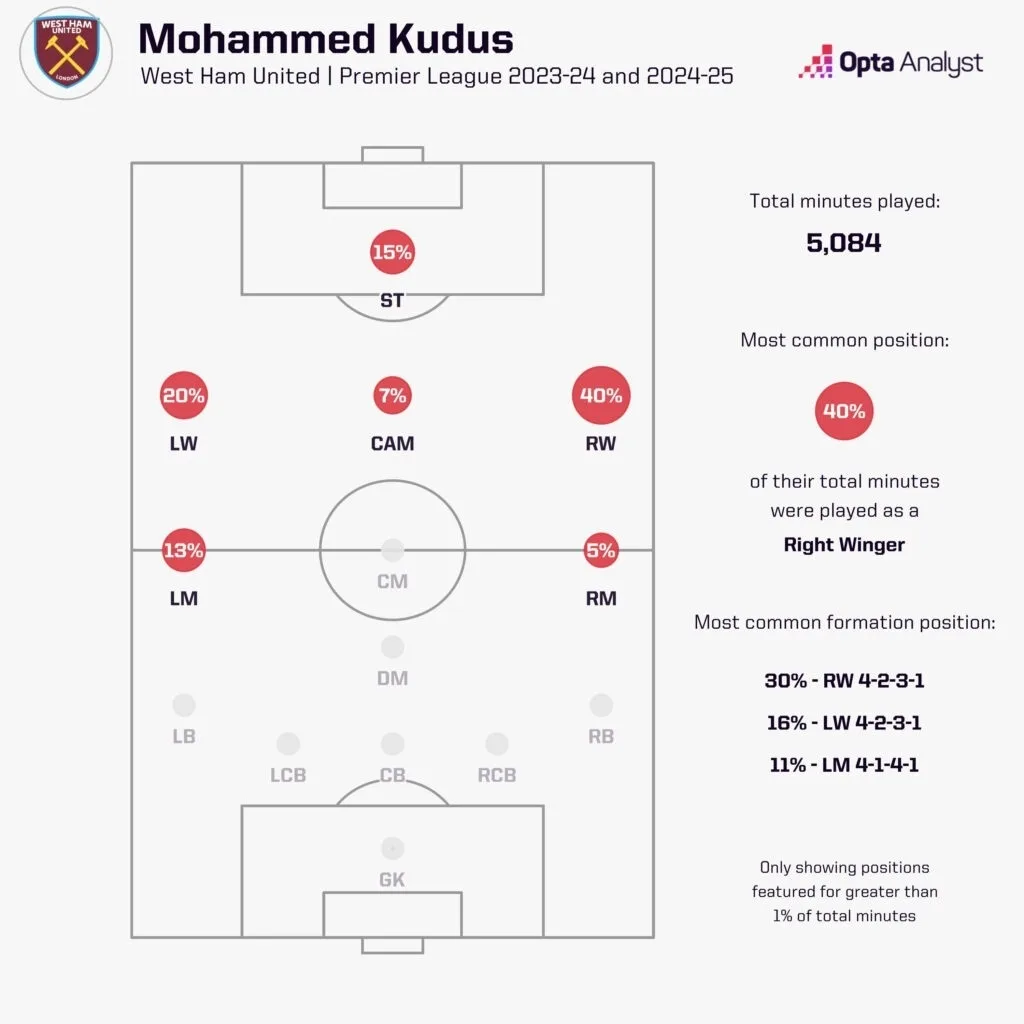
It remains uncertain whether Kulusevski will play on the right under Frank, but after a strong central season last year, it’s likely his future lies there. That leaves Kudus and Europa League final hero Brennan Johnson vying for the right-wing spot.
Kudus himself is more comfortable on the right. Last season in Premier League matches, his per-90 stats were significantly better on the right than the left, with more touches, touches inside the opposition box, shots, shots on target, chances created, possession regains (including in the final third), and shot-ending carries.
He enjoys cutting in from the right flank to attack with his stronger left foot, but he can also take the ball wide and drive toward the byline on his right side. On the left wing, his influence is more limited.
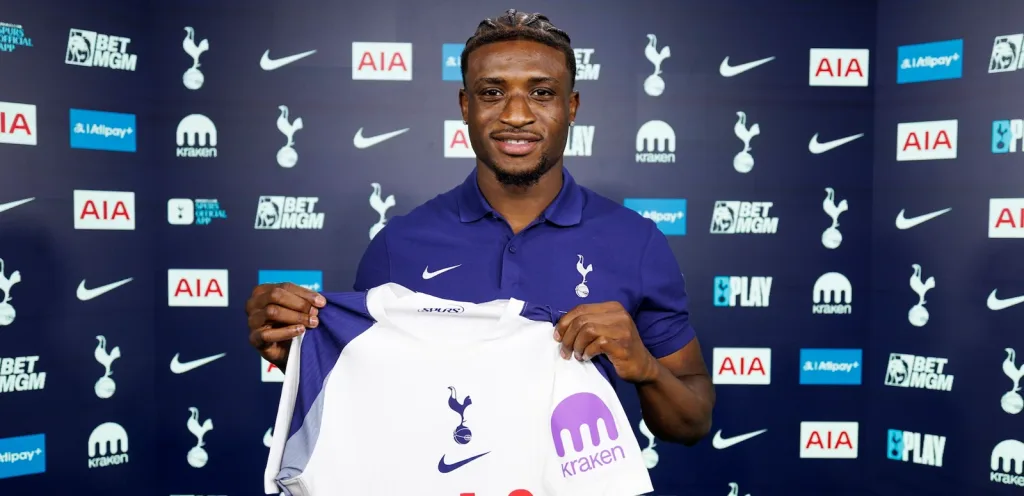
There was a clear weakness in Spurs’ squad, and Frank has moved quickly to address it. Kudus brings something Tottenham lacked, giving him the potential to make an immediate impact.
This signing clearly looks like a smart, well-thought-out move.
Read More: Noni Madueke to Arsenal: Is He a Versatile Winger or Just Saka’s Backup?
FAQs
Why did Tottenham sign Mohammed Kudus?
Tottenham needed an elite dribbler to boost their attack, and Kudus’ Premier League experience made him the perfect fit.
How does Kudus compare to other Premier League dribblers?
Last season, only Jérémy Doku completed more dribbles than Kudus, who also boasts a high success rate.
What position is Kudus likely to play at Spurs?
Kudus is expected to feature mainly on the right wing, where his dribbling and ability to cut inside are most effective.
What are Spurs’ expectations for Kudus’ goal contributions?
While Kudus’ 2024-25 season lacked end product, Spurs hope he can replicate his more productive 2023-24 form.
How can Kudus improve Spurs’ overall play?
Kudus’ skill in beating defenders can help Spurs break down defenses more efficiently and potentially strengthen their defensive balance by reducing the need to overload attacks.

